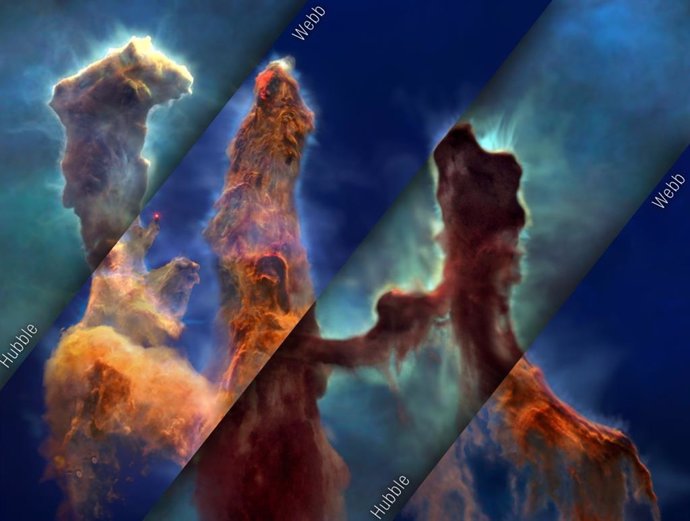June 26 () –
NASA has published a new 3D visualization of the imposing celestial structures of the Pillars of Creation using data from the Hubble and James Webb space telescopes.
It is the sequence at multiple wavelengths most complete and detailed to date of these clouds of star birth.
The Pillars of Creation, in the heart of the Eagle Nebula, They were made famous in 1995 by NASA’s Hubble Space Telescope and have captured the imagination of the entire world with their ethereal and dazzling beauty.
“By flying alongside and between the pillars, viewers experience their three-dimensional structure and see how they look different in Hubble’s visible light view compared to Webb’s infrared light view,” he explained. it’s a statement lead visualization scientist Frank Summers of the Space Telescope Science Institute (STScI) in Baltimore, who led the film’s development team for NASA’s Universe of Learning program. “The contrast helps them understand why we have more than one space telescope to look at different aspects of the same object.”
The four pillars of creation, composed primarily of cold molecular hydrogen and dust, are being eroded by strong winds and punishing ultraviolet light from nearby hot, young stars. Finger-like structures larger than the solar system protrude from the top of the pillars. Embryonic stars may be embedded within these fingers. The tallest pillar spans three light years, three quarters of the distance between our sun and the next closest star.
The film takes visitors to the three-dimensional structures of the pillars. Rather than an artistic interpretation, the video is based on observational data from a scientific paper led by Anna McLeod, an associate professor at Durham University in the United Kingdom. McLeod also served as a scientific advisor on the film project.
“We always had in mind to create the pillars of creation in 3D. The Webb data in combination with those from Hubble allowed us to see the pillars in greater detail”, said production director Greg Bacon of STScI. “Understanding the science and how to best represent it allowed our small, talented team to rise to the challenge of visualizing this iconic structure.”
The new visualization helps viewers experience how two of the world’s most powerful space telescopes work together to provide a more complex and holistic portrait of the pillars. Hubble sees objects that shine in visible light, at thousands of degrees. The Webb’s infrared vision, which is sensitive to colder objects with temperatures of only hundreds of degrees, pierces through the obscuring dust and sees stars embedded in the pillars.
“When we combine observations from NASA’s space telescopes at different wavelengths of light, we expand our understanding of the universe,” said Mark Clampin, director of the Astrophysics Division at NASA Headquarters in Washington. “The Pillars of Creation region continues to offer us new insights that sharpen our understanding of how stars form. Now, with this new visualization, “Everyone can experience this rich and captivating landscape in a new way.”
Various stages of star formation are highlighted in the visualization. As viewers approach the central pillar, they see at its top an embedded child protostar that glows bright red in infrared light. Near the top of the left pillar is a diagonal jet of material ejected from a newborn star. Although the jet is evidence of the birth of a star, viewers cannot see the star itself. Finally, at the end of one of the “fingers” protruding from the left pillar is a shiny new star.







![[Img #74683]](https://thelatestnews.world/wp-content/uploads/2024/12/The-main-mistakes-to-avoid-when-betting-on-electronic-sports-150x150.jpg)





![[Img #74683]](https://thelatestnews.world/wp-content/uploads/2024/12/The-main-mistakes-to-avoid-when-betting-on-electronic-sports-300x200.jpg)


Add Comment